Unlock the Editor’s Digest for free
Roula Khalaf, Editor of the FT, selects her favourite stories in this weekly newsletter.
If you are standing on a blazing platform, it is best to know how fast it is burning. Thames Water, however, last week warned it could run out of cash at the end of December. Just over two months ago, it had forecast adequate liquidity to survive until next May.
How has the indebted utility, battling to avoid renationalisation, mislaid five months of liquidity? The simplest answer is that Thames Water is burning through cash faster than expected, even since July. This calls into question management’s credibility. Some costs, such as suppliers demanding stricter terms, are out of their control. Others, including putting more cash into reserves under the terms of its complex financing structure, should have been foreseen. Certainly, it is less than ideal when seeking new investors to stump up £3.25bn for a turnaround.
Another answer — and Thames Water’s preferred one — is that it still does technically have liquidity until May 2025.
It needs a majority of creditors to allow it to draw on £380mn of emergency cash held in reserves. It would also need access to £420mn of undrawn facilities. Alternatively, it could enter “standstill” (in other words, default). As well as allowing it to access the £380mn of emergency cash without permission, another £550mn in liquidity reserve facilities would become available. Capital expenditure, however, would be restricted to essential maintenance.
It strains credibility (again) to suggest nothing has changed. Credit rating agencies are rattled by the disclosure of those conditions. Moody’s and S&P have cut their ratings deeper into junk territory. S&P’s simultaneous downgrade of Thames Water’s management and governance from “moderately negative” to “negative” speaks volumes. (Thames Water insists it was “very clear” that its liquidity position was dependent on both cash and undrawn facilities.)
The chances of Thames Water avoiding temporary renationalisation rest on finding new equity investors — a process that unsurprisingly prompts investor scepticism. Or it could rely on creditors. One possible solution, being examined by a group of 90 creditors holding £9bn of Thames Water’s debt, could involve an interim lending facility to tide over Britain’s biggest privatised water utility.
The creditor route looks most plausible. This would surely please regulator Ofwat, which wants creditors to agree a restructuring that would make it easier to raise equity.
It remains unclear why creditors would put up interim finance until they know that Thames Water’s regulatory settlement, which determines allowable returns over five years from April, will be enough to attract new investors.
On the current timetable, that outcome will be published on December 19, and could be pushed into January. Thames Water’s hopes of avoiding renationalisation are — like its cash balances — disappearing fast.
nathalie.thomas@ft.com


